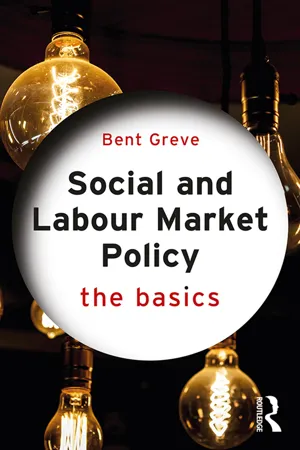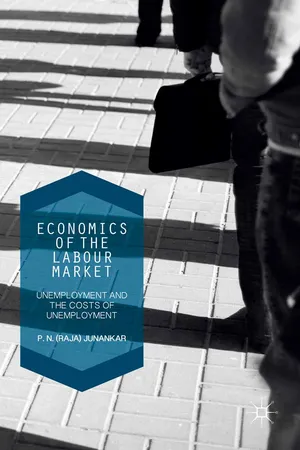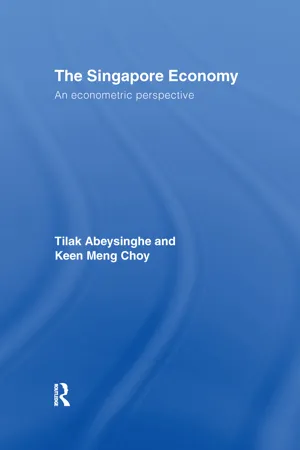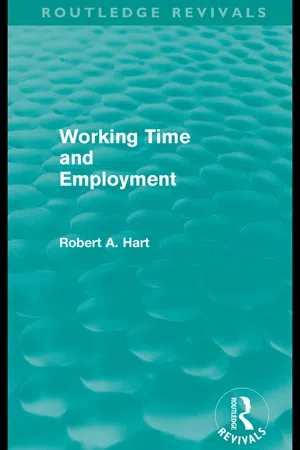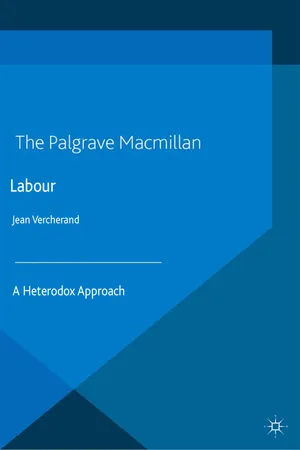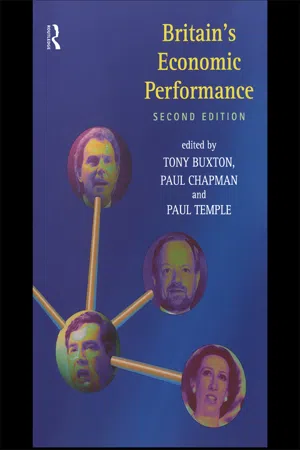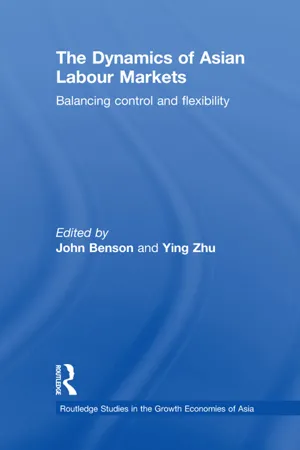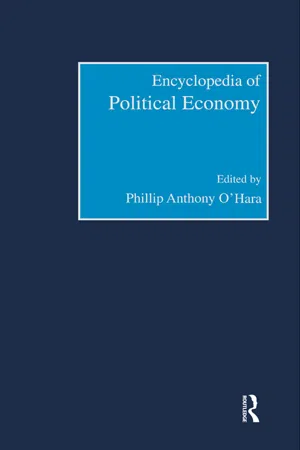Economics
Labour Market
The labour market refers to the supply of and demand for labor, where workers offer their skills and employers seek to hire them. It encompasses the interactions between employers, employees, and the government, as well as factors such as wages, working conditions, and employment levels. The labour market is a key component of the economy, influencing overall productivity and living standards.
Written by Perlego with AI-assistance
Related key terms
Related key terms
1 of 4
Related key terms
1 of 3
12 Key excerpts on "Labour Market"
- eBook - ePub
Social and Labour Market Policy
The Basics
- Bent Greve(Author)
- 2018(Publication Date)
- Routledge(Publisher)
The reasons for unemployment need not be the same over time and the same in all countries. Besides the explanations that are given in Section 6.2, Section 6.3 focuses on what has been labelled the fourth industrial revolution and its possible impact on the Labour Market. Thus, the section also presents the debate on the future of work (Greve, 2017b). This is combined with how modern technology might influence the understanding of the Labour Market. There are a variety of concepts that can be used to understand the impact of these changes, also concepts that have been used to explain the historical development. These include concepts such as dualisation, insider/outsider and the precariat, which are central to the discussion in Section 6.4.Ways of combining flexibility and security (flexicurity) have become high on the agenda both at the supranational and national levels. Section 6.5 discusses how to understand the concept and its different connotations in different welfare states, including links to a discussion on social security benefits (unemployment and social assistance), for example what is often also labelled passive Labour Market policy. The free movement of workers, especially with a focus on the EU, which has had an impact on the Labour Market, and is also questioned in some countries, is the focus in Section 6.6. The subject of the alternatives to a flexible Labour Market, for example the ALMP, is returned to in Chapter 7 . Lastly, the chapter is summed up.6.2. What is a Labour Market and employment/unemployment?
Overall, in principle the Labour Market is the market for buying and selling labour. This is what is labelled as the commodification of labour. Buying and selling implies that a worker is willing to work and accept the wage and working conditions for a specific job, and that an employer is willing to employ a person for a specific kind of job. Understood in this sense, the Labour Market is, in many ways, like many other markets for different kinds of commodities.Wages are the prices on the Labour Market and, in many countries, collective agreements influence the level of wages and working conditions. Many countries also have a legally decided minimum income.A central difference between the Labour Market and other markets is naturally that a person can accept or decline a job, except implicitly if this has consequences for receiving social security benefits, whereas this is not the case for goods on other markets. Still, the similarity is that a person who wants to sell his/her labour needs to find a buyer, and they must agree upon wages and working conditions. These might be dependent on a collective wage agreement with only limited options for individual negotiation of the wage level, but can also be fully individually agreed. There are also some EU rules and national rules which have to be fulfilled, such as working time, safety at the workplace and minimum income in some countries. - eBook - ePub
Economics of the Labour Market
Unemployment, Long-Term Unemployment and the Costs of Unemployment
- P. N. (Raja) Junankar, P. N. (Raja) Junankar(Authors)
- 2016(Publication Date)
- Palgrave Macmillan(Publisher)
2 The Labour Market 2.1 Labor Economics P. N. Junankar The field of labor economics is involved with the study of the labor market, including the determinants of employment, unemployment, and wages. The labor market developed as societies moved from feudal to capitalist processes. The development of capitalism in turn led to powerful capitalist owners and an industrial workforce that was concentrated in factories. Conditions of work became, by present Western standards, dirty, demanding, and dangerous. As a result, workers organized unions and began to demand better pay and working conditions, and they set up political organizations like the Labour Party in the United Kingdom. Over the years, organized labor managed to achieve many of their goals, as legislation was introduced in many countries to provide minimum wages, poverty relief, unemployment benefits, and pensions, and to ensure safe working conditions. The labor market consists of employers, workers, and a government that provides an institutional and legal framework. The distinctive features of labor as a commodity are: (1) except for a slave society, people can only buy and sell labor services; (2) the quality of the labor services provided depends not only on the innate ability of the workers but also on their attitudes to work, to their fellow workers, and to their employers; (3) most employment contracts last for a fairly long time, so there are not frequent repeat purchases of this “commodity”; (4) there is asymmetric information in the labor market about the “quality” of labor services; and, (5) there is an unequal power relationship in the labor market. Labor markets are different from other markets. As Arthur Okun points out in Prices and Quantities (1981), they are not auction markets that clear instantaneously, but are influenced by “custom and practice.” For example, firing is usually based on last in, first out, and seniority is often given special privileges - Cárdenas Rubio, Jeisson Arley(Authors)
- 2020(Publication Date)
- Editorial Universidad del Rosario(Publisher)
2. The Labour Market and Skill Mismatches 2.1. IntroductionThe Labour Market can be defined as a “place” (not necessarily a physical place) where employers (“demand”) and workers (“supply”) interact with each other. The dynamics of this Labour Market are relevant for an economy as they determine different socio-economic outputs, such as productivity, unemployment, wages, and poverty, among others. Provided that the Labour Market influences various outcomes and different disciplines address these issues (e.g. sociology, economy, etc.), this chapter discusses Labour Market definitions and explains the theoretical framework adopted throughout this book to analyse labour demand based on the information found on online job portals.The second section of this chapter explains what is understood by labour demand and labour supply in the academic literature on economics, and possible ways to statistically measure these concepts. Moreover, it defines and highlights informal economy as a key issue, especially in Latin American countries like Colombia. Subsequently, the concept of skills is introduced, and its possible implications for unemployment and informal economy are explained. With these basic definitions outlined, the third section of the chapter describes the Colombian Labour Market and its main outcomes, such as unemployment, wages, etc., under the assumption of perfect competition.However, the assumptions of perfect competition are substantial and might not be appropriate for different economies such as the Colombian economy. Consequently, it is necessary to consider Labour Market failures—for example, imperfect information—that might appropriately explain the comparatively high rates of informal economy and unemployment levels in Colombia. Thus, the fourth section of this chapter focuses on explaining how imperfect information might increase skill mismatches and, consequently, create Labour Market segmentation between formal and informal workers along with a comparatively high unemployment rate, proposing thus that information failures might be one of the leading causes of high unemployment and informality rates, especially in developing countries like Colombia.- eBook - ePub
Trading Economics
A Guide to Economic Statistics for Practitioners and Students
- Trevor Williams, Victoria Turton(Authors)
- 2014(Publication Date)
- Wiley(Publisher)
3 Labour Markets…the power of population is indefinitely greater than the power in the earth to produce subsistence for man.As we saw in the previous chapter, economic growth is dependent on a raft of factors. Not least among these are people – the population mentioned by Malthus in the above quote.Thomas Malthus1The exchange of labour in return for a wage is one of the defining features of industrialised societies, driving living standards, through increased specialisation and innovation, to new levels, as Adam Smith pointed out in 1776.2 In this sense, observing and understanding Labour Market trends are crucial to economic and social policy as well as investment decisions. Without human knowledge and skills, raw materials would remain just that. It is human skill and the use of knowledge to develop production methods that transform materials into goods that people want and need and that drive global economic growth.Indeed, to understand the dynamics of an economy and its comparative performance, you have to understand its Labour Market. First of all, what is its productivity? Secondly, what is the composition of the labour force and how is it broken down into the different categories that can mean so much for whether long-term growth can be sustained? Thirdly, what is the number of people in the labour force as a whole and in these categories? It is well known that the ultimate drivers of economic growth are the productivity of the labour force plus the number of people of working age (together known as factors of production). So we need to know as much about these as possible to properly judge the long-term potential for growth. After all, that is where the value addition comes from that determines rising living standards and investment returns.That's why it is important to understand Labour Markets – to see where an economy is going and, therefore, what economic opportunities exist. For instance, the most successful economies have a combination of fast growth in working-age population and fast growth in Labour Market productivity. Countries with the best mixture of these attributes will outperform those that do not have them to the same extent. - eBook - ePub
- Tilak Abeysinghe, Keen Meng Choy(Authors)
- 2007(Publication Date)
- Routledge(Publisher)
5 The Labour Market5.1 IntroductionThe Labour Market attracts a tremendous amount of attention from academics, policymakers and laymen alike. Many writers have commented on the policy issues surrounding employment, wages, productivity and the unemployment rate in Singapore (see for example Krause et al. , 1987 and Lim and Associates, 1988). Yet few have analyzed their subtle links. We provide a fresh effort to investigate the interdependent relationships between Labour Market variables in this chapter. A glance at Figure 1.1 reveals that our intention is to relate developments in the macroeconomy – especially fluctuations in aggregate output and the overall price level – to the job market.By now, the reader would have realized that the Singapore economy is a small open economy with unique features. Nowhere is this more evident than in the Labour Market. Any attempt to describe it qualitatively or quantitatively must come to terms with the following characteristics of employment and wage determination that are peculiar to the country:• The presence of a large pool of foreign workers in the labour force, with attendant implications for the demand and supply of labour. As at the end of 2004, the number of foreigners stands at 621,400 or 28% of the total workforce.• The role of the National Wages Council (NWC) in affecting aggregate wage settlements. The economy-wide pay increases recommended by the NWC every year are widely perceived to have a significant influence on wage and CPF rates.• Government intervention in the Labour Market has been particularly important. As explained in Chapter 1 , this has taken the form of foreign labour, wage and CPF policies.In the next section, the methodological framework employed to address the above features is explained. Based on it, we specify and estimate behavioural equations for employment, the labour force and real wages. Following that, our econometric model of the Labour Market is used to predict the unemployment rate in Singapore. We also discuss issues pertaining to the measurement of, and trends in, natural unemployment. Lastly, we draw policy conclusions from our empirical findings. - eBook - ePub
Bangladesh's Quest for Inclusive Development
Challenges and Pathways
- Mustafa K. Mujeri, Neaz Mujeri(Authors)
- 2022(Publication Date)
- Routledge(Publisher)
Kuznets 1955 ), and economic growth involves the gradual shift of labour from the lower-paying segment (agriculture and rural) to the higher-paying ones (modern and urban). The segmented Labour Market approach in developing countries considers three major components: the formal sector Labour Market, informal sector Labour Market, and the links between the two components.The formal Labour Market is characterised by labour supply and demand, with full market-clearing and/or institutional wage determination (e.g. Labour Market with a minimum wage) and non-market-clearing with a range of options (see, e.g., Weiss 1990 ; Stiglitz 2002 ). The working of the informal Labour Market is usually rationalised in terms of the inability of workers to enter the formal Labour Market. The analysis of intersectoral linkages has followed a variety of ways, and the key is to specify the appropriate Labour Market model to fit the country’s specific set of characteristics (see Fields 2007 ). For a country like Bangladesh, probably it is useful to have multisector models in which the Labour Markets are segmented and incorporate the key features of each segment of the Labour Market in the country.This chapter examines the nature and magnitude of the effects of population growth on labour supply and employment in Bangladesh through analysing the effects of population growth on the operation and evolution of the country’s Labour Market. On the supply side, the key features include the lags between population growth and labour force participation; effects on labour supply of population growth due to changes in fertility, mortality and migration; patterns and trends in labour force participation rates (LFPRs); and gender differences in labour supply behaviour. On the demand side, the analysis focuses on the nature of the Labour Market and key factors that determine its labour absorption capacity. The analysis also covers some key Labour Market issues, which are central to the debate between the population pessimists (with the view that rapid population growth hinders the growth of income per capita, thereby reducing the rates of savings and investment and resulting in underemployment, unemployment and poverty) and the optimists (who stress the view that population growth can stimulate both technological change and the adoption of techniques that realise the economies of scale and therefore promote economic growth) in the context of Bangladesh.1 - eBook - ePub
- Bob Hart(Author)
- 2010(Publication Date)
- Routledge(Publisher)
At given times, the firm may employ average total hours that are in excess of standard hours while, in more depressed economic conditions, it may adopt short-time working schedules. Further, there are likely to exist gaps between measured or paid-for hours of work and effective working hours that are also dependent on the prevailing economic climate. A more technical discussion of such issues is left to later chapters; here, the definition of the Labour Market is extended in order to take account of these possibilities. This is attempted with reference to the schematic shown in Figure 3.2. It is recognized in Figure 3.2 that the firm can react to a position of excess labour demand through two distinct Labour Market channels. The first, the external market, relates to the stocks of vacancies and unemployment as in Figure 3.1. The second, the internal market, recognizes the distinction between the demand for and the potential supply of manhours among existing employees within the firms themselves. In this latter respect, supply in excess of demand might consist of paid-for hoarded manhours or a willingness to work more overtime per period at the given marginal premium rate or an underutilization of standard hours due to enforced short-time working. In order to avoid extreme complexity, Figure 3.2 continues to ignore such features as part-time working and shiftworking. Suppose that, as before, there is an exogenous cut in the standard workweek that renders total desired manhours in the Labour Market to be greater than utilized manhours. Figure 3.2 Extended Labour Market schematic. Again, we assume that the demand for goods and services remains unchanged. The deficiency in manhours may now be rectified by a combination of each market’s reactions. In the first place, firms may seek to change the size of their workforce at the extensive margin; in other words, they act through the external market with similar repercussions to those described in relation to Figure 3.1 - eBook - ePub
Labour
A Heterodox Approach
- Jean Vercherand(Author)
- 2014(Publication Date)
- Palgrave Macmillan(Publisher)
2 The Neoclassical Model of the Labour Market IntroductionAccording to the basic neoclassical model, the determination of the level of employment and the unit price of labour is dealt with as belonging to a perfectly competitive market, comparable to that of a consumer good. The only difference is that the roles of the agents are reversed. On the one hand, companies are suppliers on the market for goods and demanders on the Labour Market. On the other hand, households1 are demanders on the market for goods and suppliers (of their productive services) on the Labour Market. The wage rate (or equivalently, the unit wage; still more concretely, the hourly wage) and the volume of labour (the number of people employed multiplied by the duration of their work done at a given intensity, or work rates) result in the free confrontation of the global supply of, and demand for, labour. This confrontation is schematised in the form of a Saint Andrew’s cross on a plane where the horizontal axis measures the volume of work in hours while the vertical axis measures the wage rate. Each segment of the cross expresses the relation established between the volume of labour demanded or supplied and the wage rate (see Figure 2.1 ).This Saint Andrew’s cross – common to all representations of competitive markets – is the basic scheme of the neoclassical construction. This scheme is based on a large number of hypotheses, one of which is so implicit that it is not even mentioned in microeconomic manuals as being one of the conditions that define pure and perfect competition. The segments of the cross (in reality, curves) express the fact that demanders and suppliers optimise their choices and thus are perfectly free and of independent will .Figure 2.1 The basic neoclassical representation of the Labour MarketIn this basic model, labour is considered perfectly homogeneous: all workers have the same productivity. This simplification will be conserved throughout this book, except for a few indicated exceptions. - eBook - ePub
- Martin Prachowny(Author)
- 2012(Publication Date)
- Routledge(Publisher)
3 The Market for Labor Services and the Macroeconomy It is not an exaggeration to say that interactions between buyers and sellers in the labor market are more complicated than in either the goods market or the money market. The reason for this is an intricate and ill-defined division of property rights to a job. Unlike a loaf of bread or a dollar bill, where mere possession gives the owner virtually unlimited rights to dispose of the item in question, employment gives ambiguous property rights to both the employer and the employee. The employer does not own the individual who happens to work for the firm, nor does the employee own the job that he happens to have. The principal cause of the inability to stipulate inviolate property rights to a job is that there is too much at stake, in the sense that the side holding these rights could abuse them. For example, if workers received the property rights exclusively, they presumably could not be fired, even if they were incompetent, lazy, or both. On the other hand, if firms could pay their workers whatever they wanted ex post, they would have difficulty keeping their most productive workers, who would prefer to work for themselves, rather than put up with a capricious employer. As a result, since these property rights to a job cannot be allocated on the basis of some uniformly accepted conditions, they must be negotiated between workers and their employers. These negotiations give rise to fixed costs for both parties and to minimize them they enter into long-term agreements where these property rights are allocated. Worker-employer relationships are often included in contracts, either explicit union agreements that can be enforced in the courts or implicit “hand-shake” arrangements that are binding only to the extent that tradition and a sense of “fair play” make them so - eBook - ePub
- Tony Buxton, Paul Chapman, Paul G Chapman, Paul Temple(Authors)
- 2005(Publication Date)
- Routledge(Publisher)
In attempting to explain the surprise fall in unemployment, some economists pointed to what they saw as an earlier than expected pick-up in the demand for labour after the recession, which was taken as evidence that the British Labour Market had become more ‘flexible’. Before considering this possibility it is necessary to issue a health warning; the term ‘Labour Market flexibility’ needs to be handled with care. It is sometimes used as if a syno nym for deregulated Labour Markets, but flexibility in fact refers simply to the ease with which employment and/or wages can adjust or adapt to changing conditions of demand and supply in labour and product markets. Flexibility or adaptability can be hampered by Labour Market institutions and regulations; but by the same token flexibility can be hampered by lack of regulation if and where formal rules and procedures are necessary to prevent various forms of market failure.One can distinguish between a number of broad types of flexibility: external flexibility, internal (or functional) flexibility, and wage flexibility (Beatson, 1995). External flexibility refers to the ease with which employers can adjust the number of employees they require in line with fluctuations in demand. Internal flexibility refers instead to the ability of employers to alter the hours worked by employees and/or the ease with which employees can be deployed to different tasks. Finally, wage flexibility refers to the responsiveness of wages to changes in supply and demand—in either relative terms or real terms. All these forms of flexibility can be considered either at the micro (workplace) or macro (economy-wide) levels. When discussing Labour Market flexibility it is therefore important to make clear which of these different types of flexibility is being referred to.EXTERNAL FLEXIBILITY AND JOBS
Most explanations of the early fall in unemployment following the 1990s’ recession rely on some notion of there having been an improvement in external flexibility during the 1980s. It is often argued that, unlike the preThatcher/Major era, when Britain’s Labour Market was more regulated and more strongly unionised, employers are nowadays better able to hire and fire staff in line with changes in demand. - eBook - ePub
- John Benson, Ying Zhu(Authors)
- 2011(Publication Date)
- Routledge(Publisher)
Reference has already been made above to changes in the governance of Labour Markets, in particular the decline of union power, the weakening of employers’ associations, and a shift of power to individual firms. This has had major consequences for movements towards greater flexibility and changes in wage and income patterns. It may also lie behind some of the shift from ILM-type arrangements to more ELM-type preferences on the part of employers (Aidt and Tzannatos, 2002; ILO, 2006).Political factors have always shaped Labour Markets. At an ideological level, beliefs in state intervention gave way to neo-liberal ideas from the late 1970s onwards, leading to a greater emphasis on deregulation and market forces. This varied across countries, but by now has had profound effects on most industrial economies. At a practical level, and perhaps paradoxically, it was suggested above that in many ways governments have come to intervene more and not less in Labour Markets. It is probably true to say that over time, in most countries, there has been a gradual build-up in intervention in terms of rights off-the-job (state welfare and pension systems), rights on-the-job (workmen’s compensation, health and safety, racial and sexual equality legislation), and regulation of collective employment matters (the law on trade unions, collective bargaining, and information and consultation at work) (Crouch, 1993; Hall and Soskice, 2001). In Europe, the European Union has taken these tendencies further in recent decades (Supiot, 2001).The social context is in many ways the most difficult to categorize and summarize. As has already been suggested, over the decades, the position of children and women at work has changed profoundly, at least in advanced market economies. The starting age of employment has slowly risen, and the proportion of women in paid employment has increased. Major changes have also come with rising living standards and a greater awareness of social and human rights. Over time, social identities have also changed, with notions of ‘class’ playing a significant part in worker mentalities through much of the twentieth century, but becoming less powerful in more recent decades. Other social identities at work which have long existed, on the basis of gender, race, religion, and immigrant status, have been successively reshaped and added to, with new identities in terms of age, sexual orientation, and disability (Piore and Safford, 2005). - eBook - ePub
Encyclopedia of Political Economy
2-volume set
- Phillip O'Hara(Author)
- 1999(Publication Date)
- Routledge(Publisher)
The second wave of segmented labor market research has devoted more attention to theoretical issues. Product market conditions remain central. For instance, high fixed cost/low variable cost TECHNOLOGY caters to the stable portion of product demand, and low fixed cost/high variable cost technology responds to the unpredictable component of demand. However, recent segmented labor market research emphasizes the interaction and mutual conditioning in historical time of supply and demand determinants of labor market outcomes. Thus, in explaining the relative autonomy of social reproduction, Humphries and Rubery (1984) argue that, rather than being exogenous, current gender differences in labor supply behavior are more plausibly the product of family organization, which is itself the product of historical gender differences in earning opportunities. The same interaction between supply and demand parameters, including social and political factors, led Wilkinson (1983) to underline the need for a dynamic and interactive analysis to take account of the historically contingent nature of labor market outcomes.Recent developments in mainstream labor economics made a significant contribution to the microfoundations of segmented labor markets. EFFICIENCY WAGES models explain why firms may find it unprofitable to cut wages when they knowingly confront an excess supply of qualified labor. These (mainly neoclassical) models indicate that firms may pay above market-clearing wages in order to minimize turnover costs or to minimize the labor cost per unit of work effort elicited (e.g. Bulow and Summers 1986). Insider-outsider models attempt to explain how turnover costs—costs of replacing an incumbent (insider) with an unemployed worker (outsider)—enable workers to gain the labor market power required to extract job rents (Lindbeck and Snower 1988). These costs may be production-related when due to hiring, screening, training, and negotiation activities; or rent-related when due to statutory provisions (such as severance pay), or to workers’ own rent-generating activities such as strikes.
Index pages curate the most relevant extracts from our library of academic textbooks. They’ve been created using an in-house natural language model (NLM), each adding context and meaning to key research topics.
Explore more topic indexes
Explore more topic indexes
1 of 6
Explore more topic indexes
1 of 4
